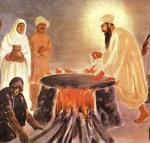Template:AOW301: Difference between revisions
Hari singh (talk | contribs) (Created page with '{{Aowh|[http://tuhitu.blogspot.com/2009/06/sakhi-series-129-bhagat-trilochan-ji.html <small>Bhagat Trilochan and Antarjami</small>]}} [[Image:Trilochan.jpg|thumb|200px|right|{{c…') |
Hari singh (talk | contribs) No edit summary |
||
| Line 1: | Line 1: | ||
{{ | {{aow|Reasons for the martyrdom of Guru Arjan}} | ||
{{pm|File:Guru Arjan accepts Will.jpg|[[Guru Arjan subjected to torture]]}} | |||
[[ | On [[16 June]] of every year since [[1606]], the [[Sikh]]s have commemorated the martyrdom of [[Guru Arjan]], the fifth [{Sikh Guru]] and the first [[Sikh Martyr]]. | ||
[[ | The story of the execution of the [[Sikh Guru]], under the orders of the [[Mughal]] [[Emperor Jahangir]] has suffered at the hands of poet, street entertainers and historians alike; the reality of the facts has been lost. | ||
In about a century after [[Guru Nanak]], [[Sikhism]] turned from a small irrelevant sect into a mass movement. Many thousands of followers followed the teachings of the [[Sikh Gurus]]; even some prominent [[Muslim]]s who enjoyed a privileged position in the [[Mughal]] state during this period embraced Sikhism. | |||
The rulers found it difficult to tolerate the growth of [[Sikhism]] and its ever-increasing popularity. The reaction of the orthodox [[Muslim]]s is found in the memoirs of [[Emperor Jahangir]], the Tuzuk-i- Jahangiri. The main reasons for the execution of the Guru can be listed under three headings- Religious, Personal and Political.<!--- | |||
With the advent of the [[Guruship]] of [[Guru Arjan]] many hundreds of thousands of the native people had began to follow the teachings of [[Sikhism]] and both [[Hindu]]s and [[Muslim]]s were crowding into [[Govindwal]] and [[Amritsar]] (the centres of the [[Sikh]]s during the late 1500s and early 1600s) where they were soon becoming [[Sikh]]s.---> {{aowf|Reasons for the martyrdom of Guru Arjan}} | |||
Revision as of 19:28, 10 October 2010
On 16 June of every year since 1606, the Sikhs have commemorated the martyrdom of Guru Arjan, the fifth [{Sikh Guru]] and the first Sikh Martyr.
The story of the execution of the Sikh Guru, under the orders of the Mughal Emperor Jahangir has suffered at the hands of poet, street entertainers and historians alike; the reality of the facts has been lost.
In about a century after Guru Nanak, Sikhism turned from a small irrelevant sect into a mass movement. Many thousands of followers followed the teachings of the Sikh Gurus; even some prominent Muslims who enjoyed a privileged position in the Mughal state during this period embraced Sikhism.
The rulers found it difficult to tolerate the growth of Sikhism and its ever-increasing popularity. The reaction of the orthodox Muslims is found in the memoirs of Emperor Jahangir, the Tuzuk-i- Jahangiri. The main reasons for the execution of the Guru can be listed under three headings- Religious, Personal and Political. .....More

